
Hoatzin
"The Hoatzin (Opisthocomus cristatus) is curious and highly specialized. "The body is long and thin,…
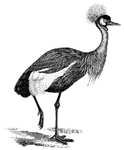
Crowned Crane
"Balearica pavonina, the "Crowned" Crane of the Northern Ethiopian Region, is greenish-black above and…
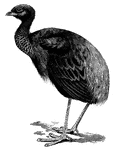
Trumpeter
"Psophia crepitans, the Agami, ranging from British Guiana to Amazonia, is a black bird with velvety…
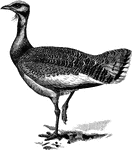
Great Bustard
"The Otis Tarda, the Great Bustard, which, as a native only became extinct in Norfolk about 1838, used…
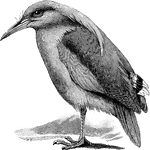
Kagu
"Rhinochetus jubatus, the Kuga ... has powder-down patches that are profusely distributed over the whole…

Sun-Bittern
"Eurypyga helias, Sun-Bittern, has a black head, with a white stripe above and under each eye, and a…
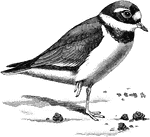
Ringed Plover
"Aegialitis hiaticola, the Ringed Plover, Sand-Lark, or Stone-runner, mistakenly called the "Ring-Dotterel"…
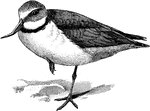
Wry-bill
Anarhynchus frontalis, the Wry-bill of New Zealand, is grey, with a black gorget and whitish lower parts;…

Woodcock
"Scolopas rusticula, the well known Woodcock, brown, grey, and buff in color, with blackish vermiculations…

Indian Jacana
"Hydrophasianus chirurgus, the Indian Jacana, of most of the Indian Region, is Bronzy-brown above and…
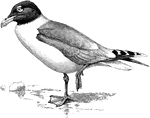
Great Black-Headed Gull
"Larus ichthyaetus, the Great Black-headed Gull, ranging from the Black Sea and the Levant to Tibet,…

Pallas's Sand Grouse
"Syrrhaptes paradoxus, Sand-Ground, are true desert birds, affording excellent instances of protective…
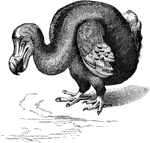
Dodo
"The Dodo, ...was an immense Pigeon-like bird bigger than a Turkey, with an aborted keel to the sternum…
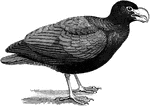
Tooth-Billed Pigeon
Didunculus strigirostris, the Manu-mea or Red Bird of the islands of Upolu, Salvai, and Tutuila in Samoan…
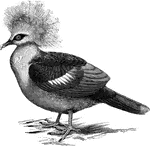
Crowned Pigeon
"Goura coronata, the Crowned Pigeon, discovered by Dampier in 1699, is bluish-slate -coloured, with…
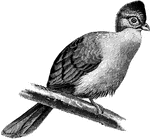
Green-Mantled Turaco Sitting on a Tree Limb
"The Gallirex chlorochlyamys, Green-mantled Turaco, has a general coloration of metallic blue and green…
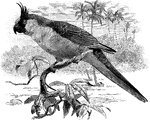
Uvaean Parakeet
The Nymphicus uvaeesis, Uvaean Parakeet, has a dark coloured face, black beak, green plumage and crest,…
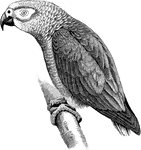
Grey Parrot
"Psittacus erithacus, the Grey Parrot, which ranges across Equatorial Africa, is ashy-grey, with black…
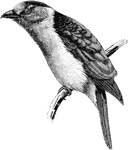
Kirombo
"Leptosoma discolor, the Kiromobo or Vorondreo of Madagascar, and the Comoro Islands, which has a big…

Motmot
"Momotus brasiliensis, the Motmot, from Guiana to Northern Brazil, is somewhat similar in colour (to…

Racquet-Tailed Kingfisher
"Tanysiptera, the Racquet-tailed Kingfisher or "Paradise Kingfisher", the sexes may be similar or dissimilar,…
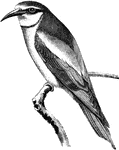
Bee Eater
"Merops Apiaster, the Bee-eater, has ruddy-brown head, neck, upper back, and broad alar bar, buff lower…
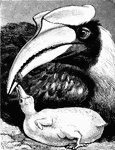
Female Hornbill Laying Down Feeding Her Young
"Dichoceros bicornis of India and the Malay countries has a large yellowish-red casque, hallowed and…

Hoopoe
"Upupa epops, not unfrequently visits Britain, where it has nested on several occasions; it breeds from…
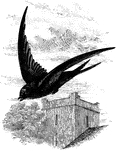
Common Swift Flying Through the Air by a Structure and a Tree with its Mouth Open
"The coloration of the twenty or more species of Cypselus is sooty-black or mouse-brown, frequently…

Long Tailed Hummingbird
"Aithurus polytmus, the Long-tailed Hummingbird, peculiar to Jamaica, the two tail-feathers next to…
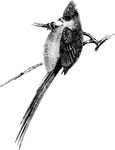
Cape Coly
"Colius capensis, or Cape Coly, has two stripes of black on the back enclosing one of white, the bare…
Quezal
"Pharomacrus mocinno, the Quezal of the higher districts of Guatemala to Veragua, is brilliant iridescent…
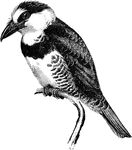
Puff-bird
"Bucco hyperrhynchus, or Puff-bird, is blue-black, with a white under surface crossed by a broad black…
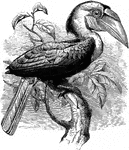
Plait-billed Hornbill
The Rytidoceros undulatus, Plait-billed Hornbill, or Wreathed Hornbill, has black wings, belly, and…
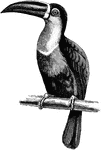
Ariel Toucan
The Rhamphastus ariel, or Ariel Toucan, is black with a yellow or orange rump and throat. The brilliant…
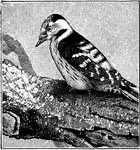
Lesser Spotted Woodpecker
"Dendrocopus minor, or Lesser Spotted Woodpecker, are the British representatives, The colours in this…
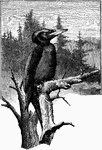
The Great Black Woodpecker
"Picus martius, the Black Woodpecker, an inhabitant of the pine-forests of Europe and Asia to Japan,…
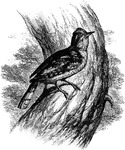
A Wryneck Sitting on a Tree
"Iynx torquilla, the Cuckoo's-mate or Snake-bird, is fairly common in England, and extends thence to…
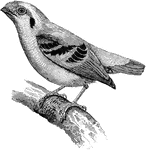
A Broadbill Sitting on a Tree Branch
"The plumage in the Calyptomena viridis of the Indo-Malay countries is bright green, with large black…
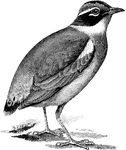
Indian Pitta
"Pitta brachyura, the Indian Pitta, has plumage that exhibits vivid scarlet, blue, and green tints,…
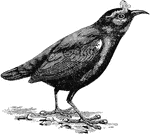
Wattled Pittas
"Philepitta, peculiar to Madagascar, which have bare orbits surmounted by a green caruncle in the male,…

Red-capped Manakin
Pipra mentalis, the Red-capped Manakin, has black plumage with a red head, neck, and thighs.
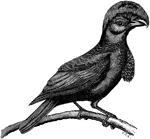
Amazonian Umbrella Bird
"Cephalopterus ornatus, the Umbrella bird, is entirely black, with a huge expanded umbrella-like crest…
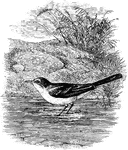
Yellow Wagtail
"Motacilla raii, the Yellow Wagtails, are generally black and white, grey and white, grey with a yellow…
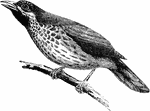
Babbling Thrush
"Timelia maculata, the Babbling Thrush, sexes are commonly alike, the plain rufous coloration being…
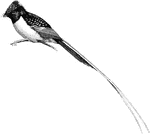
Paradise Flycatcher
"Terpsiphone paradisi, Paradise Flycatchers, have fine crests, shorter in the female; while fleshy wattles,…
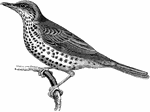
Mistletoe Thrush
"Turdus viscivorus, Mistletoe Thrush, the coloration is ordinarily plain black or brown, more or less…
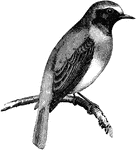
Redstart
"Our Ruticilla phoenicurus,the Redstart, is grey, with brown wings, chestnut breast, rump, and lateral…
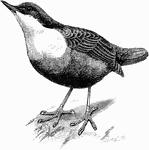
Dipper
"Cinclus aquaticus, Dippers, the colour above is normally greyish-black or brown; the lower parts are…
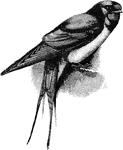
Swallow
"Hirundo rustica, the Swallow, is metallic black, with a variable amount of chestnut or rufous on the…
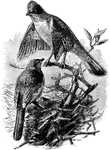
Two Grey "Coly-Shrike" Birds Sitting on Tree Branches
"Hypocolius ampelinus, Grey "Coly-Shrike", the plumage is soft, with characteristically stiff shafts…
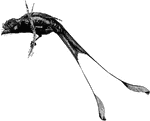
Drongo
"Dissemurus paradiseus, the Drongo, both sexes are typically black, with metallic gloss of blue, purple,…
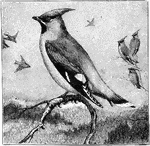
One Waxwing Sitting on a Branch in the Forefront with Three Waxwings Sitting on Branches and Four Flying Around in the Background
"Both sexes of our irregular winter-visitor the Waxwing (Ampelis garrulus) are silky greyish-brown,…
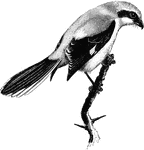
Great Grey Shrike
"The Lanius excubitor, Great Grey Shrike, lax plumage is either black, grey, and white, or is varied…

Nuthatch
"The colours in Sitta caesia, (Nuthatch) which ranges over nearly all the Palaearctic and Indian Regions,…
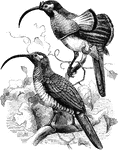
D'Albertis' Bird of Paradise
"Drepanornis albertisi, D'Albertis' Bird of Paradise, is rufous-brown, with green throat and ante-ocular…
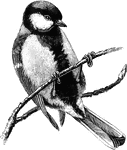
Great Titmouse
"Parus major, the Great Titmouse, are olive, brown, or grey, varied with black, white, chestnut, or…
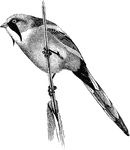
Reed Pheasant
"Panurus biarmicus, the "Bearded Tit" or "Reed-Pheasant" plumage is orange-brown above, with grey crown…
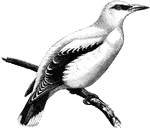
Golden Oriole
"The Golden Oriole, Oriolus galbula, which breeds exceptionally in England, is orange-yellow, with black…
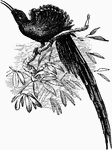
Long-tailed Bird of Paradise
"Falcinellus speciosus, Long-tailed Bird of Paradise, is black with rainbow-like reflections; the broad…
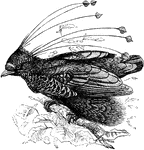
Six-wired Bird of Paradise
"Parotia sexpennis, the Six-wired Bird of Paradise, is bronzy- and purplish-black, having scale-like…
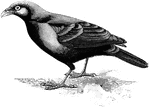
Satin Bower-bird
"Ptilorhynchus violaceus, the Satin Bower-bird, is purplish-black, with much feathered culmen. Female…
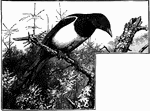
A Magpie Sitting on a Tree Branch Looking Down While Surrounded by Other Trees
"The Pica rustica, or Magpie, extends through the Palaearctic Region, and reaches Formosa and North…
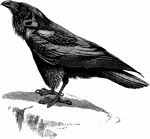
Raven
"Corvus corax, the Raven, are generally black with a purplish or greenish gloss, and frequently with…